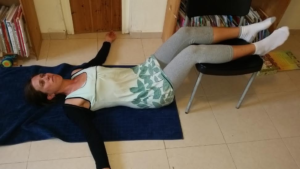 Women, it’s time to relax. I recommend taking ten minutes at the end of the day to listen to your body, to unwind and to just let go. Your daily relaxation can take many forms but it definitely involves getting off your feet and not worrying about money or kids or the dishes in the sink.
Women, it’s time to relax. I recommend taking ten minutes at the end of the day to listen to your body, to unwind and to just let go. Your daily relaxation can take many forms but it definitely involves getting off your feet and not worrying about money or kids or the dishes in the sink.
When we put ourselves out in the world, we are primed for action. Our muscles respond to environmental stimuli, constantly contracting and stretching. When we are in stressful situations, and stress can come from an infinite number of sources (a mean boss, missing the bus, checking your bank account, loud noises, getting jostled in the shuk) our muscles contract and stay contracted, forming tight knots in the middle of the muscle. Depending on your body, this can translate into back pain, a stiff neck, a tension headache or sore shoulders by the end of the day.
Some women get into the habit of clenching their pelvic floor muscles (Levator Ani) for most of their waking hours. Having a strong pelvic floor is one thing but nobody wants a muscle spasm in their pelvic floor. Like every other muscle in the body, your pelvic floor muscles are designed to contract and relax. Relaxing your pelvic floor is just as important as strengthening it. If your levator ani stays scrunched up all the time, you’ll be very uncomfortable. You might be constipated, suffer from pelvic or back pain, and even have trouble emptying your bladder, which can lead to urinary tract infections. Sex is also infinitely more enjoyable when your pelvic floor both contracts and relaxes. The first part, contracting the pelvic floor is called Kegels. Most women are familiar with kegels, and likely do hundreds of day. Great! Keep on doing kegels.
The second part, relaxing the pelvic muscles, is called a Negel. It is the opposite of a kegel and I encourage you to incorporate the negel into your daily 10 minute relaxation routine as a way of releasing stored tension in the muscles of your lower back, pelvis, hips and abdomen. Here’s how you do a negel:
Find a quiet moment, put on loose clothing and find a place to stretch out comfortably. Lie on your back with your calves supported by a chair or physio ball. Just let your abdominal and back muscles relax for 10 deep breaths.
The Negel: Take a deep breath and while exhaling, try to imagine an opening up of your pelvic floor as if you are about to urinate and it is the second before you actually let go. Repeat five times.
Once you get the hang of it, try negeling while going into a deep squat. I hope this brings you and your pelvic floor some relief and I’d love to hear your feedback about this exercise.
Tali Ginsburg is a physical therapist (US and Israel certified) specializing in pelvic floor dysfunction, lymphedema and orthopedics. She runs a private women’s clinic in Jerusalem, providing attentive, timely, individualized care in a comfortable atmosphere. For more information on prolapse or any other women’s health issues visit www.taliginsburgphysio.com or e-mail Tali at tgriffel@gmail.com.








Leave A Comment